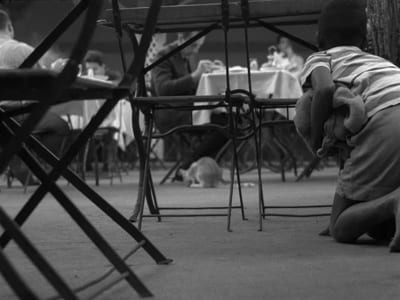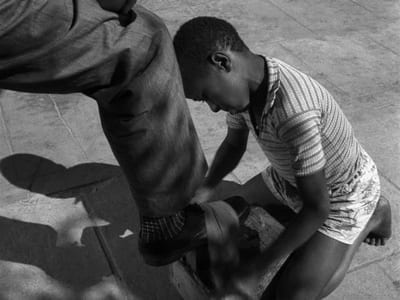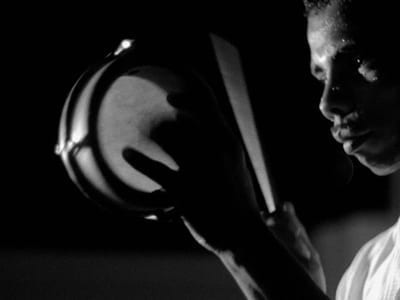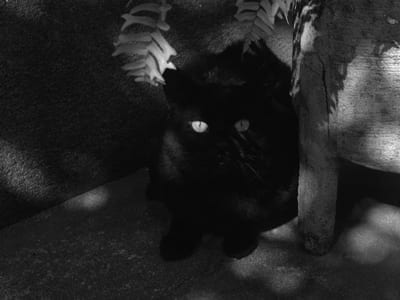|Class Carnival|
In the introduction to the screening of The Priest and the Girl (O Padre e a Moça, 1966) last week at NYU, Robert Stam pointed out an ambivalence, or perhaps even a contradiction, in how Joaquim Pedro de Andrade understood Oswald de Andrade’s concept of “anthropophagy” – the Modernist embrace of cultural cannibalism as a distinct survival strategy in underdeveloped countries. Stam mentioned that Oswald celebrated this attitude in which “only what’s not mine interests me,” while Joaquim Pedro incorporated anthropophagy as a critique of the predatory structure of Brazilian society. The joy of every meal is ultimately linked to sacrifice.
Couro de Gato (Cat Skin, 1962) is perhaps the film in which this ambivalence is more seamlessly expressed – even more than Macunaíma (1969), or his biopic on Oswald himself, O Homem do Pau Brasil (The Brazilwood Man, 1982) – for it is the film in which cannibalism is entangled within a Marxist framework, and a faithful investment on the ironically invisible conventions of social realism.

Cannibalism, capitalism, the currency of the flesh. In Cat Skin, the stomach is a thinking organ, and the lower body is the organizing entity that feeds a voracious assembly line. While the flesh is central in the quest for cat skin to make “tamborins,” the film refuses to treat the carnivalesque pursuit as an exceptional curiosity that ends with the beginning of Lent. The world of the film is neatly tied with strings of flesh: the leather shoes that the kids shine to make a living; the steak that the men eat at the restaurant, and that both the cat and the boy greed; the rotting fish tied to a string to hook the cat’s attention; the gluttony in the gaze of the woman who sees the puppy-eyed poor boy outside her luxurious house. The film stretches this social tissue with an ingenious use of wide angle lenses, keeping the foreground and the background in permanent contradiction; a well-orchestrated crosscutting that leads the multiple cannibalistic cycles towards the apotheosis of a chase scene; and a vertiginous summing of different points of view, perhaps best exemplified by the web of gazes in the restaurant scene: the boy watches the cat who watches the steak that is watched (and eaten) by the man.
But Cat Skin is not only a film about class struggle. It is Carnival, after all, and a drum won’t sound without a skin. In the same way that Joaquim Pedro covers his film with different incarnations of flesh, there are also the circular shapes that recall not the skin, but the structure of the drum: the garbage can used as a trap in the park; the barrel that the slum cat rests on; the tins used to roast and sell peanuts in the streets of Rio; the cookies that one of the boys share with the cat before coming to terms with the fact that only one of them will make it out alive. In the film, class struggle and carnival create a self-feeding system without a clear end or beginning, like the samba drums seamlessly bond with Carlos Lyra’s evocative orchestration. In order to survive in this land of inversions where everything gets mixed and then violently separated, it is not only essential to learn to distinguish the party from the property, but also to know when and how everything is brought together.


* * *

Carnaval de classes
Na apresentação à sessão de O Padre a Moça (1966) semana passada na NYU, Robert Stam sugeriu uma ambivalência, ou talvez uma contradição, na maneira como Joaquim Pedro de Andrade entendia a proposta antropofágica de Oswald de Andrade, e seu abraço modernista ao canibalismo cultural como estratégia de sobrevivência no subdesenvolvimento. Stam mencionou que Oswald celebrava essa atitude na qual “só me interessa o que não é meu”, enquanto Joaquim Pedro incorporava a antropofagia como crítica à estrutura predatória da sociedade brasileira. A satisfação de cada refeição está intimamente ligada a um sacrifício.
Couro de Gato (1962) talvez seja o filme que expressa essa ambivalência de maneira mais transparente – mais até que Macunaíma (1969), ou O Homem do Pau Brasil (1982), seu biopic de Oswald – por ser o filme em que o canibalismo aparece atrelado a uma compreensão de mundo marxista, e a um investimento de fé na poética lisa do realismo social.

Canibalismo, capitalismo, os cifrões da carne. Em Couro de Gato, o estômago é órgão pensante, e as partes baixas são a entidade que organiza e alimenta uma cadeia de produção voraz. Apesar de a carne ser elemento central na busca pelo couro de gato para fabricar tamborins, o filme não trata a busca carnavalesca como exceção curiosa que se expira com a Quaresma. O mundo do filme é delicadamente embalado com fios de carne: os sapatos de couro que os garotos engraxam para ganhar um troco; o bife que os homens comem no restaurante, para a cobiça do garoto e do gato; o peixe putrefato amarrado no barbante como isca à atenção do gato; o afeto glutão da mulher rica que vê o garoto pobre, com olhos de cão abandonado, no portão de sua mansão. O filme tenciona esse tecido social com um uso inspirado da lente grande-angular, mantendo figura e fundo em permanente contradição; uma exímia montagem paralela que deságua os vários ciclos canibais na apoteose conjunta de uma cena de perseguição; e um acúmulo vertiginoso de diferentes pontos de vista, melhor exemplificado na teia de olhares na cena do restaurante: o menino olha o gato que olha o bife que é vigiado (e devorado) pelo homem.
Mas Couro de Gato não é somente um filme sobre luta de classes. Afinal, é carnaval, e o som do tamborim só vibra junto à pele. Da mesma maneira como Joaquim Pedro povoa o filme com diferentes encarnações da carne, as muitas formas circulares remetem não ao couro, mas à estrutura do tambor: a lata de lixo usada como arapuca no parque; o tonel onde dorme o gato na favela; os latões usados para torrar e vender amendoim nas ruas do Rio; os biscoitinhos que o garoto compartilha com o gato antes de se resignar à certeza de que só um deles seguirá vivo. No filme, luta de classes e carnaval criam um sistema que se retroalimenta, sem distinguir onde uma começa e o outro termina, com a naturalidade súbita com que a batida do surdo puxa as orquestrações de Carlos Lyra. Para sobreviver nesta terra de inversões, onde tudo se mistura para depois ser violentamente apartado, é essencial aprender não só a diferenciar a engrenagem e a festa, mas também saber quando e como tudo se junta, se indistingue, se digere, se devora.








Leave a Reply